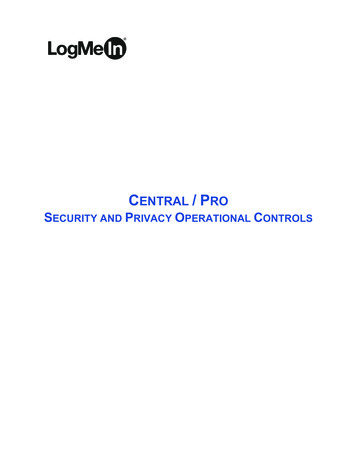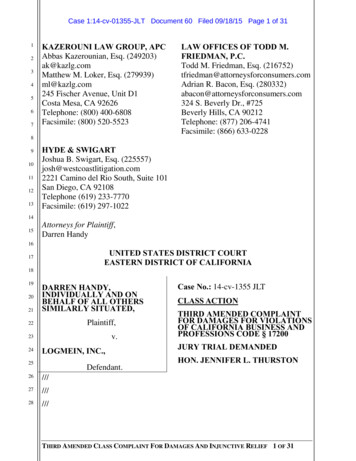
Transcription
LogMeIn HamachiGetting Started Guide
ContentsWhat Is LogMeIn Hamachi?.3Who Should Use LogMeIn Hamachi?.3The LogMeIn Hamachi Client.4About the Relationship Between the Client and Your LogMeIn Account.5About the Hamachi Virtual IP Address.5LogMeIn Hamachi Network Types .6About Mesh Networks.6About Hub-and-Spoke Networks.6About Gateway Networks.7LogMeIn Hamachi Subscription Types.9How to Change or Purchase Hamachi Subscriptions.10How to Purchase Subscriptions from the LogMeIn Website.10How to Purchase Subscriptions from the Hamachi Client.10Managing LogMeIn Hamachi Clients and Networks.12LogMeIn Hamachi Security.13LogMeIn Hamachi and Firewalls.13Installing LogMeIn Hamachi.14Hamachi System Requirements.14How to Sign up for a LogMeIn ID.14How to Install the Client to a Local Computer.15On Windows or Mac.15On CentOS (Linux).15On Ubuntu (Linux).15How to Deploy the Client to a Remote Computer.16How to Install a Hamachi Client in Client-Only mode.17How to Update the Hamachi Client.17On Windows or Mac.17On Linux.18Managing LogMeIn Hamachi Networks.19How to Join an Existing Network.19On Windows and Mac.19On Linux.19How to Add a Hamachi Network.19How to Add a Hamachi Network from the Client.20On Windows or Mac.20On Linux.20How to Approve or Reject Join Requests.21How to Delete a Network.21How to Leave a Network.21LogMeIn Hamachi Glossary.23Legal Notice.25iiLogMeIn Hamachi Getting Started Guide
What Is LogMeIn Hamachi?LogMeIn Hamachi is a virtual networking service that can be set up in minutes and enables secureremote access to your business network anywhere there is an Internet connection.Unlike traditional hardware and software based VPN systems, Hamachi is an on-demand virtualnetworking service that allows you to focus your time and energy on providing the remote connectionsyour users and systems need, and not the technology or infrastructure you are using to support them.Who Should Use LogMeIn Hamachi?Here are a few examples of how you can take advantage of Hamachi.IT Support: Building a Mobile Office LANMany mobile workers use their laptops in the office while connected to their company's shared resources(file servers, network printers, mail servers, etc.). But if a user moves away from the local network, hewill no longer be able to access these resources. Software that is configured to work inside the officebecomes useless outside the office.Using Hamachi, mobile workers become members of a Hamachi network wherein all shared resourcesare also network members. As a result, network configurations can remain unchanged. Hamachi setsup exactly the same networking environment for the mobile user no matter where he is.Tip: Hub-and-spoke and gateway are the best networking modes for this scenario.IT Support: Setting Up Network Access for Home WorkersHome workers can be more productive when they have secure access to shared IT resources. Usingthe Hamachi client, home workers gain a secure tunnel directly into their company's network. They canwork from home and still access the resources they need.Tip: Hub-and-spoke and gateway are the best networking modes for this scenario.Outsourced IT: Managing Multiple NetworksA service provider with a number of administrators on his team wants to set up and maintain multipleHamachi networks for multiple customers. He uses LogMeIn Central to create Hamachi networks,deploy Hamachi clients, and apply default and custom settings for each customer. He can also manageother administrators in his organization, generate client activity reports, and manage network activity.Small to Medium Sized Organizations: Virtual LANOrganizations without a physical LAN can use the mesh network type to set up a virtual corporate LAN.Copyright 2017 LogMeIn, Inc.3
The LogMeIn Hamachi ClientThe term Hamachi client refers to both the Hamachi software itself and any computer or smartphonewith Hamachi client software installed. With proper permission from network owners, Hamachi clientscan become members of any Hamachi network.Figure 1: The LogMeIn Hamachi client for WindowsFigure 2: The LogMeIn Hamachi client for MacA command-line version of LogMeIn Hamachi is also available for Linux and officially supported on thefollowing distributions: Ubuntu 16.04 LTS or newer CentOS 7.2 or newer4LogMeIn Hamachi Getting Started Guide
About the Relationship Between the Client and Your LogMeIn AccountThe Hamachi client can only be used with a LogMeIn ID, as an attached member of a LogMeIn account.About the Hamachi Virtual IP AddressEvery Hamachi client has one virtual IPv4 (IP) address in the 25.x.x.x range and one IPv6 address. Thevirtual IP address is globally unique and is used to access the client from any other Hamachi networkwith at least one common mesh or hub-and-spoke network.Copyright 2017 LogMeIn, Inc.5
LogMeIn Hamachi Network TypesLogMeIn Hamachi provides three network types for flexibility in meeting diverse use case scenarios:Mesh, Hub-and-Spoke, and Gateway. They differ mainly in network topology.About Mesh NetworksIn a mesh network, every member is connected to every other member.Organizations without a physical LAN can use the mesh network type to set up a virtual corporate LAN.Mesh is also the typical choice for gamers, because network games constantly have to broadcast theircurrent status to all other participants in the game.Figure 3: Mesh networkNote: Mesh is the only network type that can be created directly from the Hamachi client interface.About Hub-and-Spoke NetworksIn a hub-and-spoke network, one or more computers act as hubs, while other clients connect as spokes.Spokes connect to hubs, but never to each other.Hub-and-spoke is typically used when a workstation (spoke) needs to connect only to servers (hubs).For example, in a library, the catalog is a hub while workstations accessing the catalog are spokes.Hub-and-spoke is ideal if you want strict control over connections between network members.Figure 4: Hub-and-spoke networkImportant: If you set every member of a hub-and-spoke network to be a hub, you essentially turnthe network into a mesh network. Similarly, if you set only spokes, your members will be unableto make a connection.6LogMeIn Hamachi Getting Started Guide
About Gateway NetworksUse the gateway network type to provide transparent access to your entire network from a centralizedHamachi gateway. Members of a gateway network, such as mobile workers, will see one computeracting as a gateway towards an entire LAN, thus making all network resources accessible.Figure 5: Gateway networkTip: Theoretically, a hub-and-spoke network would also be a good choice for enabling mobileLAN access; however, all shared resources would also need to be running the Hamachi clientand be set up as hubs. This is fine insofar as these shared resources are servers with a Hamachicompatible operating system; however, the gateway network remains the best option sinceHamachi currently cannot be installed on network devices such as printers, routers, access points,etc.Important: Mac hosts cannot act as gateway nodes.CharacteristicsThe gateway network type is a hybrid of the meshed and hub-and-spoke network types: As in a hub-and-spoke network, one computer acts as a hub (the gateway), while members act asspokes There can only be one gateway, which is typically a permanently online server connected to the LAN The number of members is virtually unlimited since even network devices that are not running theHamachi client can be considered members Each member (Hamachi client) will see the gateway and the other members of the gateway's LAN Hamachi clients will not see each other in a gateway networkRestrictionsFor technical and security reasons there are strict rules for both the gateway and members: The gateway cannot be a member of any other network Members can join more than one gateway network, but can only be online in one network at a time.Gateway members can also be members of multiple non-gateway networks The gateway cannot be a workstation that is the member of a domainRole of the Hamachi Client in a Gateway Network Gateway network members and the gateway device itself must be running the Hamachi client Network devices that are physically connected to the LAN do not need to run the Hamachi client tobe made accessible to gateway network membersCopyright 2017 LogMeIn, Inc.7
AddressingGateway networks integrate smoothly into the LAN in terms of addressing. 25.x.x.x addresses are notavailable for a gateway network. Instead, the local address space is used.8LogMeIn Hamachi Getting Started Guide
LogMeIn Hamachi Subscription TypesEvery Hamachi user must have either a paid or free subscription to join or create Hamachi networks.Free, Standard, and Premium LogMeIn Hamachi subscriptions are available at the network level. Youcan have an unlimited number of Free, Standard, and Premium networks in your account, in anycombination. Standard and Premium subscriptions are purchased for and applied to individual networks.Regardless of the type and number of subscriptions you purchase, you can attach a maximum of 256clients to your LogMeIn account; the number of clients is independent of the number of members pernetwork.Subscription typeValid for this many networksMembers per networkFreeUnlimited5Standard1 (purchased individually, pernetwork)32Premium1 (purchased individually, pernetwork)256The Multi-Network subscription option is applied across an entire LogMeIn account, allowing you anunlimited number of networks with up to 256 members per network. With Multi-Network you are stillsubject to the limit of 256 clients per account. The number of clients allowed at the LogMeIn accountlevel is independent of the number of members per network. This means that you can have potentiallyfar more members in your networks than clients attached to your account.Tip: When attempting to add a new client, you may be informed that you have reached your clientlimit. If this occurs, you must create "free space" in your account by removing an unused client.Otherwise, the client can only join your network if it is attached to another account and joins yournetwork as a guest.Subscription typeValid for this many networksMembers per networkMulti-NetworkUnlimited256Tip: The current and maximum number of network members are displayed on the Hamachi clientnext to the name of the network. For example, 11/256 means that there are 11 members in anetwork that can have up to 256 members.What if I do not want to renew my subscription?Standard, Premium, and Multi-network subscriptions are paid subscriptions that allowyou to have more than five members in your network. If your network has more thanfive members, you should take the following into consideration before you cancelyour subscription: Your network will not accept any new members. Only five members will be active. Other members will be disabled (offline) in yournetwork until you resolve this issue by purchasing a subscription or evicting networkmembers.Copyright 2017 LogMeIn, Inc.9
Your network will still be fully functional but only for five randomly selectedmembers. You can renew your expired subscription any time.What if I never had a paid subscription?For free networks, only five members remain active and you are unable to add newmembers. For example, a free network that was created with 14 members beforeintroducing Standard, Premium, and Multi-network subscriptions will be functionalfor five random members and will not accept new members.Important: If you have more than five members in a network and you chooseto have a free subscription, you will not be able to add new members until youremove some of them from the network.How to Change or Purchase Hamachi SubscriptionsDepending on the size of your network you can purchase several types of subscriptions. You can buya Hamachi subscription either from the LogMeIn website or from the Hamachi client. See LogMeInHamachi Subscription Types on page 9.How to Purchase Subscriptions from the LogMeIn Website1. On the My Networks page, click Edit next to the network you want to work with.The Edit Network page is displayed.2. Select the Subscription tab.Your current subscription is selected.3. Select a subscription type that you want to use or purchase.4. Switch to the selected subscription: Click Change subscription if you have already purchased the selected subscriptionClick Buy subscription to purchase a new subscription and follow all instructionsYour changes are applied.How to Purchase Subscriptions from the Hamachi Client1. Do one of the following to open the LogMeIn Hamachi website: Click Manage Manage Networks.If you see a blue warning icon next to the name of your network then1. Click the blue warning icon next to the name of the network that you want to upgrade.2. Click Upgrade options.The Hamachi website opens in your browser.2. Log in to your LogMeIn account: 10Click Create Account if you do not have a LogMeIn account yet and follow all instructions.LogMeIn Hamachi Getting Started Guide
Click the Login link if you have a LogMeIn account.The subscription purchase page opens.3. Select the type and number of subscriptions you want to buy and click Buy Now.4. Follow all instructions to complete your purchase.Copyright 2017 LogMeIn, Inc.11
Managing LogMeIn Hamachi Clients and NetworksHamachi Web Management FeaturesAny Hamachi user with a LogMeIn account can manage attached clients and networks using the LogMeInweb site (My Networks page). Create mesh, hub-and-spoke, and gateway networks Remotely manage client settings Manage the default settings to be applied to a new network Edit or delete existing networks Install the Hamachi client to the local computer Deploy the Hamachi client to a remote computer Manage requests to join Hamachi networksHamachi Client Management FeaturesHamachi clients provide access to the following features: Create mesh networks Manage the default settings to be applied to a new network Edit or delete existing networks created on the client Install the Hamachi client to the local computer Deploy the Hamachi client to a remote computer (Not available on Linux) Manage requests to join Hamachi networksFree versus Paid SubscriptionsHamachi is free for users if they have no more than five computers per network. The paid version offersfast relays and is subject to an annual subscription fee.For information about subscription types, see LogMeIn Hamachi Subscription Types on page 9.12LogMeIn Hamachi Getting Started Guide
LogMeIn Hamachi SecurityAll LogMeIn Hamachi communications are encrypted and authenticated with industry-standard algorithmsand protocols. Nobody will be able to see the data transmitted between two Hamachi peers. For detailedinformation, see the LogMeIn Hamachi Security Whitepaper.LogMeIn Hamachi and FirewallsIf running a firewall application, you may need to ensure that Hamachi is able to access the Internet.Please refer to the LogMeIn Hamachi Knowledge Base for up-to-date information for working withvarious popular security suites.Copyright 2017 LogMeIn, Inc.13
Installing LogMeIn HamachiHamachi System RequirementsImportant: A LogMeIn ID is required to attach Hamachi clients to networks. For details, see Howto Sign up for a LogMeIn ID on page 14.LogMeIn Hamachi has been tested with the following operating systems: Windows Vista (All versions), Server 2008 Standard Edition, Small Business Server 2008 Windows 7 (All versions), Server 2008 r2 (All versions) Windows 8, 8.1 (Desktop UI only) Windows 10 Windows Server 2012 Mac OS 10.6 (Snow Leopard) or newer on Intel-based Macs Linux distributions: Ubuntu 16.04 LTS or newer CentOS 7.2 or newer Internet connectionNote: Windows RT is not supported.Gateway Node functionality is not available on the following platforms due to limitations within theoperating systems themselves: Mac OS Windows Small Business Server editions Any operating system deployed on Microsoft AzureHow to Sign up for a LogMeIn IDSign up for a LogMeIn ID to use LogMeIn software and services. No obligation. No credit card required.Your LogMeIn ID provides a single login experience for the following LogMeIn products and serviceson every platform. LogMeIn (client and host) Central join.me1. Go to www.LogMeIn.com.2. Click Log In in the upper-right corner.The Log in or sign up page is displayed.3. Click Sign up.14LogMeIn Hamachi Getting Started Guide
4. Fill in the registration form and follow all on-screen instructions.Upon completing the account form you will be sent a confirmation email.5. Carefully follow all instructions in the email you receive from LogMeIn regarding account activation.Can't find an email from LogMeIn? Check your junk or spam folder.How to Install the Client to a Local ComputerFollow this procedure to download and install the Hamachi client to a local computer. The client will beattached to your LogMeIn account.On Windows or MacImportant: You must be logged in to the LogMeIn account to which you want to attach the newHamachi client.1. On the LogMeIn web site, switch to Network mode and click Add Client.The Add Client page is displayed.2. Select Install LogMeIn Hamachi on this computer and click Continue.3. Click Install LogMeIn Hamachi.The Hamachi installer is launched.4. Follow the on-screen instructions.The client is installed on the local computer as an attached member of the active LogMeIn account.You will be able to manage this client using the LogMeIn website.On CentOS (Linux)Install Hamachi via the command line.1. Download Hamachi using the terminal.wget 0.165-1.x86 4.rpmThe installer package is downloaded to your current directory.2. Install the package.sudo yum install logmein-hamachi-2.1.0.165-1.x86 4.rpmThe client is installed on the local computer.Important: Before you can connect to a network, you must attach the client to your LogMeInaccount.1. Execute sudo hamachi login to log in.2. Execute sudo hamachi attach [email@example.com] using your LogMeIn ID (email address)to attach your client.On Ubuntu (Linux)1. Option 1: Install Hamachi via the command line.Copyright 2017 LogMeIn, Inc.15
a) Download Hamachi using the terminal.wget http://www.vpn.net/installers/logmein-hamachi 2.1.0.165-1 amd64.debThe installer package is downloaded to your current directory.b) Install the package.sudo dpkg -i logmein-hamachi 2.1.0.165-1 amd64.deb2. Install the package using the Ubuntu Software app.a) Navigate to http://www.vpn.net/.b) Click the appropriate package to download it.c) Open the .deb package with Software Install.The Ubuntu Software window is displayed.d) Click Install.e) When prompted, enter the admin password for elevation.The client is installed on the local computer.Important: Before you can connect to a network, you must attach the client to your LogMeInaccount.1. Execute sudo hamachi login to log in.2. Execute sudo hamachi attach [email@example.com] using your LogMeIn ID (email address)to attach your client.How to Deploy the Client to a Remote ComputerFollow this procedure to send an installation link that the recipient can use to download and install theHamachi client. The client will be attached to your LogMeIn account.Important: You must be logged in to the LogMeIn account to which you want to attach the newHamachi client.Note: This functionality is not available on Linux.All defaults set under Configuration Client Defaults will be applied to the new client(s).1. On the LogMeIn web site, switch to Network mode and click the Deployment link.2. Click Add New Link.The Deploy LogMeIn Hamachi to remote computer(s) (Step 1 of 2) page is displayed.3. Type a Description that you can use to recognize your installation link.4. In the Maximum number of remote installations box type the maximum number of computers thatwill be able to use the link to install the Hamachi client.For example, you may want to send the link to all users in an entire department.5. In the Expiration field you may choose when you want the validity of the link to expire.6. Select the Network(s) that you want the client to be able to access.7. Click Continue.The Deploy LogMeIn Hamachi to remote computer(s) (Step 2of 2) page is displayed.8. Send the link to the recipient(s):16LogMeIn Hamachi Getting Started Guide
Click Copy to place the link onto your clipboard for you to paste into an email or instant messagingservice message to send to the user(s)Click Send to open your default email client with the link in the body of the message for you tosend to the user(s)Click Test to view the message that will be displayed when the recipient clicks the linkThe link is sent to the recipient.The recipient must click on the installation link to actually install the client on the chosen computer.Once installation is complete, the client can be used to create and connect to Hamachi networks.How to Install a Hamachi Client in Client-Only modeFollow this procedure to download and install the Hamachi client without associating it with a LogMeInaccount.Important: Do not log in to your LogMeIn account.Note: Hamachi for Linux is installed in client-only mode by default. To detach a Linux client, seeHow to Detach (Delete) a Client from Your AccountYou can detach a client from your LogMeInaccount and remove it from all networks in your account. The Hamachi client software will remaininstalled on the local computer. .1.2.3.4.Go to the LogMeIn Hamachi product page.Click the Try it free link.Do not create a LogMeIn account.Click the Download Now link at the bottom of the page.The Hamachi installer is launched.5. Follow all on-screen instructions.After the installation is complete, the Hamachi client starts up automatically.How to Update the Hamachi ClientThis procedure must be executed on the client.On Windows or MacThe Hamachi client software can be updated from the client itself.By default, the Hamachi client downloads updates automatically when you restart your client or whenyour client is online for a week. You should download updates manually if you turn off automatic updates. To check whether you receive automatic updates, go to System Preferences Settings and verifythat the Enable automatic update option is selected.To manually download client updates, click Help Check for Updates.Copyright 2017 LogMeIn, Inc.17
On LinuxHamachi for Linux can be updated manually.1. Open the terminal.2. Execute the following command:sudo hamachi check-updateThe Hamachi version information is displayed.3. If your client is not up-to-date, follow the steps in this article: How to Install the Client to a LocalComputer on page 15.18LogMeIn Hamachi Getting Started Guide
Managing LogMeIn Hamachi NetworksHow to Join an Existing NetworkThis procedure must be executed on the client.Depending on the settings of the individual Hamachi networks, the owner of the network may have toapprove your request before you can join.On Windows and Mac1. Select Network Join an existing network.2. Type the network ID and password of the network.3. Click Join.Where do I find my network ID?If you created a network on the client, your network ID and network name are the same. You find yournetwork ID by hovering the mouse over the network's name.If you created a network on the web, you find your nine-digit network ID by clicking Edit next to thenetwork's name.On Linux1. Open the terminal.2. Execute the following command:sudo hamachi join network ID Where do I find my network ID?See the following article for details: Hamachi for Linux FundamentalsGet started with Hamachi for Linux.How to Add a Hamachi Network1. On the LogMeIn web site, go to the Networks My Networks page.Your Hamachi networks and clients are listed.2. On the My Networks page, click Add Network.The Add Network (Step 1) page is displayed.3. Name the network in the Network name field.Use the network name to help identify the network.4. Select a Network type.See LogMeIn Hamachi Network Types on page 6.Copyright 2017 LogMeIn, Inc.19
Important: Once a network is created, its network type cannot be changed.5. Enter a Network description (optional).6. Click Continue.The Add Network (Step 2) page is displayed.7. Select the default response to join requests.OptionDescriptionAccept automaticallyAll requests to join the network will be accepted automatically.We recommend that you require a network password when usingthis option.Must be approvedAll requests to join the network must be approved on the web.Members can be added on theweb onlyClients will not be able to join the network from the client. Clientscan be added to the network on the web only.8. Under Network password, select A password is required to join this network to protect yournetwork.Tip: If you do not set a password, we recommend setting the Join Request behavior to Mustbe approved or Members can be added on the web only.9. Click Continue.The Add Network (Step 3) page is displayed.10. Follow the on-s
Ubuntu 16.04 LTS or newer CentOS 7.2 or newer 4 LogMeIn Hamachi Getting Started Guide. About the Relationship Between the Client and Your LogMeIn Account The Hamachi client can only be used with a LogMeIn ID, as an attached member of a LogMeIn account. . 10 Lo










